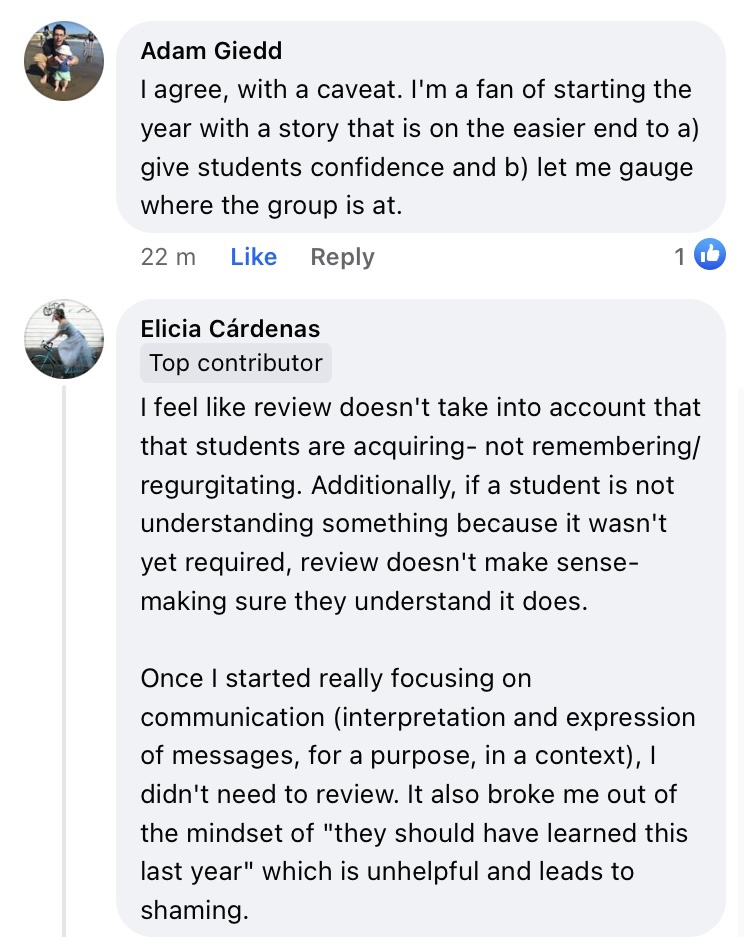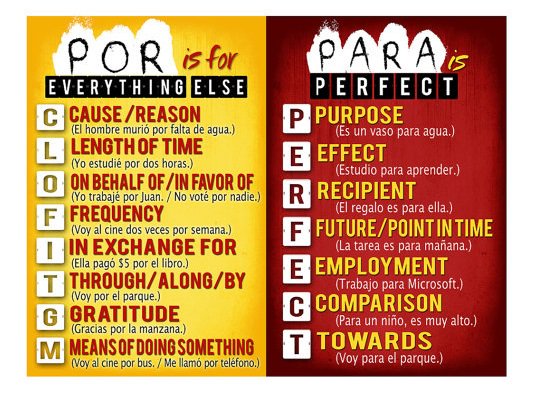Kids, parents and colleagues often ask us why do we do stories in Blablabian class, and read so much Blablabian? or why don’t we practise speaking Blablabian more? or why don’t we study Blablabian grammar like they do in Mr Smith’s class?
These are good questions. Now, since most kids and parents, and an unfortunately staggering number of teachers, administrators, heads, and methods instructors in Uni don’t, won’t or can’t read S.L.A. research, we have to be able to get people to think about why we teach languages basically by using comprehensible stories and reading that recycle vocabulary a lot. Our best explanation will be, because it works, and we show the kids, colleagues, parents or admins what kids can understand and do. We can also point them to the user-friendly Tea With BVP radio show/podcast. We can also do the best thing of all time: ask our students, do you feel like you are understanding lots of Blablabian, and is it easy?
But sometimes you want to make a point quickly, or get people thinking, so, today’s question: how do I explain comprehensible input teaching? Some of these are my ideas, and others come from Robert Harrell and Terry Waltz.
Q: Why don’t we study Blablabian grammar like they do in Mr Smith’s Blablabian class?
A: Ask the questioner, so knowing grammar rules is important to be able to speak a language? When they say yes, say OK, let’s do a simple experiment. First, ask them to tell you three things they did last night. They’ll say something like first I went home and ate Pizza pops, and then I did homework that totally sucked, and after dinner I played Minecraft on my Xbox.Then, say OK, now tell me three things you did last night, but do not use the letter “n.” This will open the door to a conversation that can show them why having to consciously think about language while using it will basically cripple our ability to talk.
Q: Why don’t we/your students/my children in your classes practise talking?
A: Ask the person what language that you don’t know would you like to learn? They might say Urdu, or Dari, or French. Then say to them OK, let’s start speaking Urdu.
At this point, they will say yes but I don’t know how to say anything. Then you say something like well, how would you like to learn to say something, and they will say something like by listening to it or by reading or watching it and you say exactly! You can now talk about how input, and lots of it, must– and does– precede any kind of output.
Q: Don’t people need grammar rules explained to them to be able to speak?
A: Ask whether or not the sentence “I enjoy to run” sounds right. When they say, no, ask why not? Most people will say uhhhhh, while the grammar freaks will say well the verb to enjoy must be followed by a noun or a gerund bla bla bla. Right…and now you ask them when you were a kid, who explained that rule to you? What, wait, nobody? Well then how did you pick it up?
This is where you can talk about what polyglot Kato Lomb (21 languages) said: we learn grammar from language, not language from grammar.
Q: Don’t people need to memorise a lot of vocabulary to learn a language? Why don’t you get your students to study vocab lists?
A: Ask them, could you explain how to turn a cellphone off? Obviously: simply find the button, and press the button long enough. Now, ask them, can you tell me how to draw a cube? Here, I have pen and paper, explain away.

When they try to tell you what to do to make this cube, you will probably end up with something very different from this nice neat cube.
The point? Some activities that we do are simple enough to first explain and then simply do, like turning a phone on or off. In school, things low on Bloom’s taxonomy, like memorising some dates for a history class, or doing long division, can easily be broken down into steps, practiced, and mastered. Basiclaly, if a computer can or could do it, we can learn it by breaking it down into steps.
Other activities, however, are so complex that breaking them down into steps or chunks is either impossible or not worth the effort. You could theoretically “explain” how to draw a cube, but it would be way easier to just show somebody a cube and have them go at experimenting with copying it. Similarly, you could ask students to memorise twenty Blablabian words (or some grammar “rules”) for a test. But it would be much simpler to get them to listen to some sentences containing the words, explain what the sentences mean, and then ask them some questions about the sentences (ie circle them) in order to recycle the words.
Q: I learned Blablabian from textbooks, memorising word lists, and studying grammar. I can still speak it. Why should we do anything differently? (This question btw is one that I have never heard from a parent, but rather from some older languages teachers.)
A: First, we ask Mr Old Grammar Student a couple of questions in Blablabian, speaking at the speed of at which native speakers of Blablabian. One of two things will happen: 1. MOGS will not understand the question, or 2. MOGS will get it and give us a fluent answer.
If MOGS doesn’t understand, the point is moot.
If MOGS gives us a fluent answer, we then ask, have you done anything to acquire Blablabian other than study the text etc? The answer is always one or more of the following: yes, I lived in Blablabia for three years, or I married a Blablabian who did not speak English, or I watch Blablabian-language news, or I really enjoy watching the Blablabian soap opera ROTFL BFF OMG LULZ on Netflix.
At this point, one can politely bring up Lance Piantaggini’s point that how we actually acquired Blablabian might differ from how we think we acquired it. The way I put it is this: can you tell me how much of your Blablabian came from Blablabian experiences, and how much came from the text? Even if people don’t know, we point out that, at best, a student of Blablabian in a five-year high-school Blablabian program got 500 hours of Blablabian (and, if the teacher was using a textbook, probably a lot less). If they lived in Blablabia, they got that much exposure to Blablabian in six weeks!
At this point, only a hardened grizzled grammarian fighting the noble battle of the textbook will stick to their guns, and say something like well grammar preparation made it possible for me to go out and experience real-life in Blablabia successfully. At this point we might say, and what percent of your students will eventually end up in a Blablabian immersion environment? but frankly I would rather at this point go and grab a couple of beers.
Ok folks, there it is, a few simple ways to get people thinking about why C.I. works.












